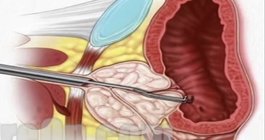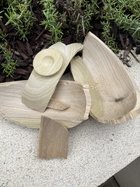Intriguing subject title, isn’t it? I have to warn you that it might be a bit graphic for some, but bear with me and you will understand—or just stop reading.
I’m a retired urologist learning woodturning. There’s a strong parallel to a common prostate surgery called TURP or transurethral resection of the prostate, known colloquially as a roto-rooter.
In hollowing, one has boundaries: preserving the walls of the form, not creating a funnel by penetrating the base, and preserving the neck or opening. Prostate surgery, specifically a TURP, is exactly the same—with an enlarged prostate obstructing urine flow, tissue is resected in a similar fashion as wood is removed in a hollow form. The prostate wraps around the urethra below the bladder neck and is reached surgically via the urethra. Think of the prostate as an orange and all the pulp needs to be removed, leaving the peel or capsule—just like in a hollow form where the desired wall thickness is left after removing all of the interior.
In a TURP, a scope is passed via the urethra and the prostate tissue is removed circumferentially down to the capsule, using an electrically charged loop via a resectoscope. Some surgeons use a laser. It’s just like passing tools in a form to hollow it out. Boundaries are similar to a hollow form with the same caveats—avoiding perforation and damage to the neck—but we also have to deal with bleeding and potential patient movement. However, the patient is not spinning at 800 rpm!
We smooth out the interior and remove all the tissue, leaving just the shell.
We use a camera video system as with some hollow forms and at the end of the procedure, all the shavings—called chips—are removed.
In the photo below one sees the prostate (to the left of bladder) before removal of tissue, so the urethra is obstructed, akin to a hollow form before hollowing.
Here’s a brief video that shows some of the procedure.
View: https://youtu.be/YujsTfjxT0o?si=TLrTy5Oj2XQnwJS7
Start at about 30 seconds, then go to 7 minutes if bored. The surgeon starts resecting tissue until a large cavity is left from bladder neck (bottom of the hollow form) to the veru, a structure that marks the location of the sphincter that controls urination, the “opening” of the hollow form.
It interests me that the parallels are so strong between this surgery and turning a hollow form.
I’m a retired urologist learning woodturning. There’s a strong parallel to a common prostate surgery called TURP or transurethral resection of the prostate, known colloquially as a roto-rooter.
In hollowing, one has boundaries: preserving the walls of the form, not creating a funnel by penetrating the base, and preserving the neck or opening. Prostate surgery, specifically a TURP, is exactly the same—with an enlarged prostate obstructing urine flow, tissue is resected in a similar fashion as wood is removed in a hollow form. The prostate wraps around the urethra below the bladder neck and is reached surgically via the urethra. Think of the prostate as an orange and all the pulp needs to be removed, leaving the peel or capsule—just like in a hollow form where the desired wall thickness is left after removing all of the interior.
In a TURP, a scope is passed via the urethra and the prostate tissue is removed circumferentially down to the capsule, using an electrically charged loop via a resectoscope. Some surgeons use a laser. It’s just like passing tools in a form to hollow it out. Boundaries are similar to a hollow form with the same caveats—avoiding perforation and damage to the neck—but we also have to deal with bleeding and potential patient movement. However, the patient is not spinning at 800 rpm!
We smooth out the interior and remove all the tissue, leaving just the shell.
We use a camera video system as with some hollow forms and at the end of the procedure, all the shavings—called chips—are removed.
In the photo below one sees the prostate (to the left of bladder) before removal of tissue, so the urethra is obstructed, akin to a hollow form before hollowing.
Here’s a brief video that shows some of the procedure.
Start at about 30 seconds, then go to 7 minutes if bored. The surgeon starts resecting tissue until a large cavity is left from bladder neck (bottom of the hollow form) to the veru, a structure that marks the location of the sphincter that controls urination, the “opening” of the hollow form.
It interests me that the parallels are so strong between this surgery and turning a hollow form.
Attachments
Last edited:


